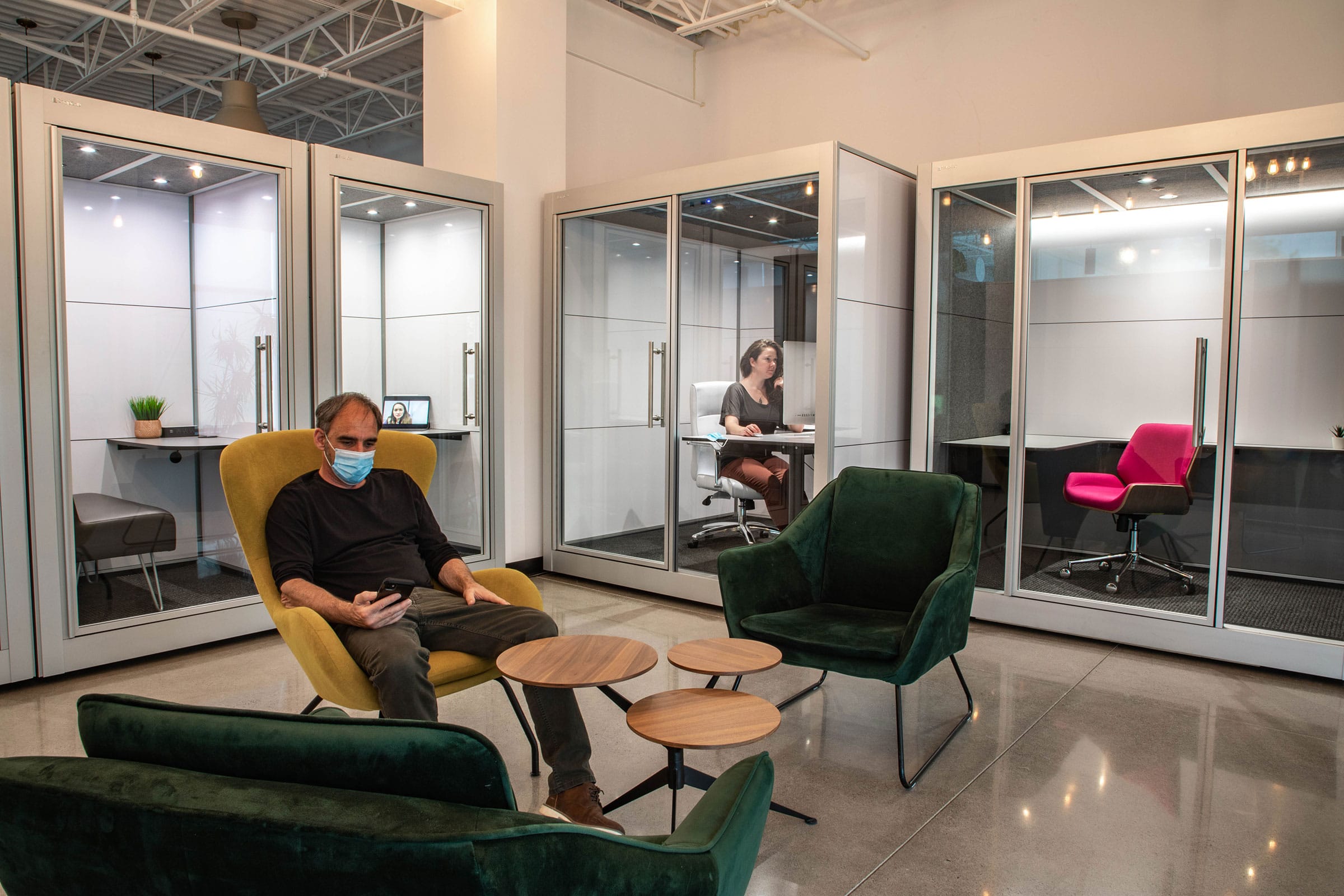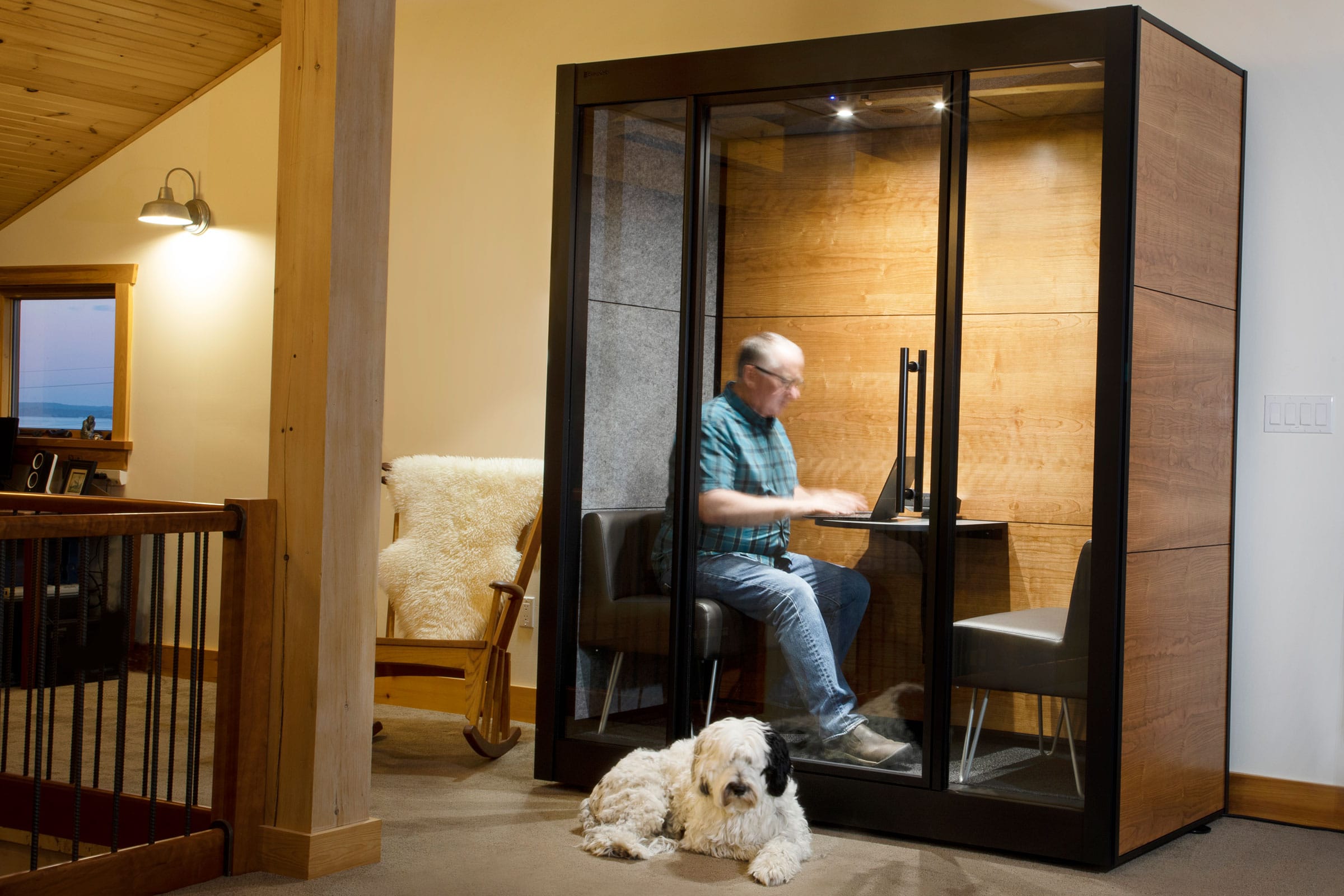
SnapCab provides innovative working solutions at Fractal Workspace. Photo courtesy of SnapCab Workspace
SnapCab Workspace’s modular workstations bring flexibility to the open office and give you the space to be you.
For much of the last decade, the trend in workplace design was toward the open office environment. The bottom-line benefit was obvious: Without cubicles and spacious corner offices, companies could fit more employees into a given space. It was also thought that an open office, free of physical barriers, would break down creative barriers between employees and lead to a more collaborative work environment. Yet the rapid spread of the novel coronavirus has upended this model and caused organizations to reconsider the future of their workspaces.
Few companies are better positioned to shape that future than SnapCab Workspace, a leading manufacturer of modular workstations. “Our first thought after the coronavirus outbreak was, ‘Will we be able to stay in business?’” says Glenn Bostock, CEO and founder of SnapCab. “But we quickly realized our workstation pods could be an excellent solution to the challenges of getting people back to work.” The company immediately began investing in research and development to further modify its product line with the challenges of the coronavirus in mind.

SnapCab Workspace’s modular workstations bring flexibility to the open office and give you the space to be you. Photo courtesy of SnapCab Workspace
Building the Brand
Bostock, who has a background in fine woodworking, started his business in a barn with his wife Cheryl in 1983. “We began with custom cabinetwork and in the 1990s transitioned into elevator remodeling,” he says. A national contract with Otis Elevator launched SnapCab from a four-person outfit to the global operation it is today. Yet it wasn’t until the 2016 AIA Conference, when a WeWork consultant commented on the possibility of modifying their elevator cabs into work pods, that the company jumped into designing modular workspaces.
SEE ALSO: Flexible Office Space and Pushing the Limits at Salesforce Tower
Even before the pandemic, the drawbacks of an open office layout were becoming evident. “Prior to the virus we were heavily focused on solving the problems of the open office environment,” says Jack Burkom, sales manager at SnapCab Workspace. “We like an open office, but you’re going to run into issues with privacy and concentration when too many people occupy a common space.” Tasks, like taking a confidential phone call or holding a small group meeting become a challenge, and finding a quiet area to focus on complex tasks, is nearly impossible.
Timely Products
The company’s existing product line is geared toward solving these pain points and creating a more flexible work environment. For example, the SnapCab Focus acts as an acoustically controlled single-person workspace. The Meet 4 and Meet 6 areas the names imply—ideal for small team meetings of four and six people and breakaway sessions. All models are constructed around a durable aluminum frame and equipped with sound-dampening glass, motion-activated lighting, and air ventilation. The pods themselves are set on caster wheels for increased mobility.
In a world deeply affected by the coronavirus, SnapCab Workspace has been moving with diligence to design the next generation of modular workstations. “We’re currently working on a new ‘consultation pod,’ which will seat two people separated by a glass partition, equipped with a fresh air supply,” Bostock says. By fitting the pods with HEPA filters, employees who return to work can hold face-to-face meetings without needing to wear a mask or sit 6 feet apart.
The company is currently investing in a system that will easily convert the Meet 4 and Meet 6 into spacious one-person “office isolation pods” for use in a shared workspace. They’ve also developed a demountable wall system that easily attaches to any pod, allowing companies to further adapt an open office setting. “With SnapCab Connects, you can create flexible neighborhoods within a space while promoting social distancing,” Bostock says.
And with the further acceleration of the work-from-home movement, SnapCab Workspace is designing a single-person home office pod, known as the Meet 2. “Using a smaller frame than our standard collaboration pods, this pod has been designed to cater to those looking for a personalized home office solution,” Bostock says. “Even working from home can be a challenge with different distractions going on.”
SnapCab Workspace is hardly the only player in the modular workspace market, but it quickly gained traction with Fortune 500 companies for one reason: “We’re uniquely positioned because of the flexibility of our pods,” Burkom says.
This quality is evident from the installation process. “Building out an office the traditional way takes time,” says Kyle Mullin, product manager at SnapCab Workspace. “You have codes to follow, drywall installation, inspections, electrical. With our pods you can have this up in a day.” That doesn’t mean the system lacks safety features—quite the contrary. “The pods are based on the design of elevator cabs, and elevators require a lot of regulation,” he says, adding that the pods are seismic certified and UL Listed.

The SnapCab Meet 4 is a mobile, stand-alone workspace for up to four people that are made of high-quality materials and allows for work to get done quietly and safely. It features a sound-blocking glass front door and is designed to interconnect with SnapCab Connects. Photo courtesy of SnapCab Workspace
Flexible Design
The flexibility of SnapCab Workspace’s modular workstations extends to their design as well. “Designers love us,” Burkom says. The clean classic lines and variety of aesthetic options “really allow designers to take control and create what they want out of the product.” The workstations can be modified to fit the client’s specific needs by adding custom features, including those suited to nursing mothers in the workplace.
The full effect that the coronavirus will have on the commercial office sector is yet to be seen, but the trend toward flexible, human-centric workspaces will likely continue. The potential of SnapCab Workspace to facilitate that trend caught the attention of the Institute for Human-Centered Design, which is collaborating with SnapCab on a coworking project. “As a byproduct of the global pandemic crisis, we’re poised at the point of reinventing work,” says Valerie Fletcher, the institute’s executive director. “SnapCab Workspace is uniquely positioned as an asset to that effort. Their focus on quality construction and continuous innovation positions them to be responsive to a world in which we will demand flexibility and safety in where and how we work.”


